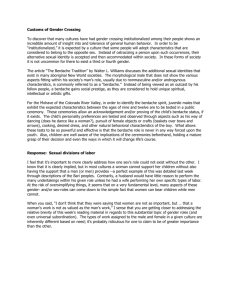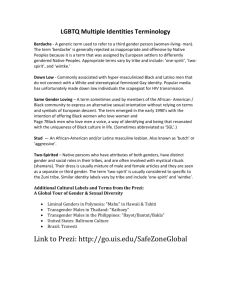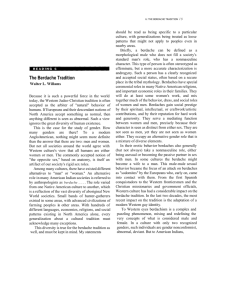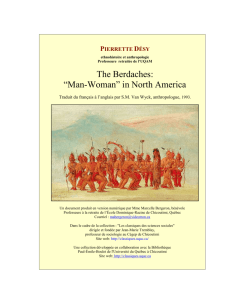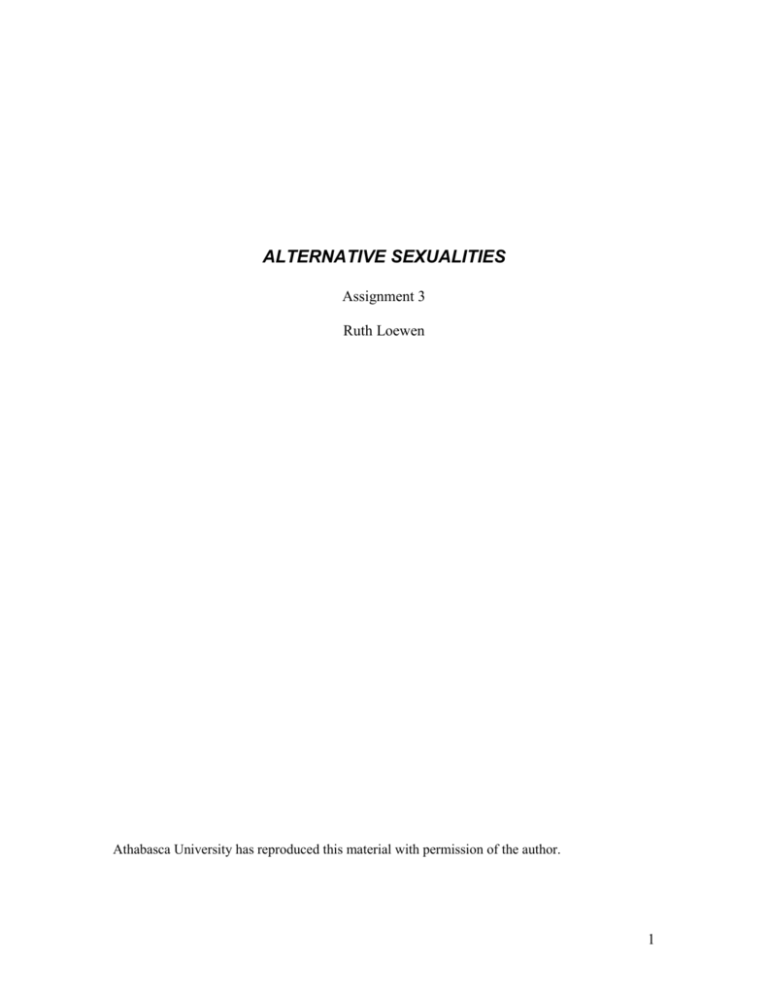
ALTERNATIVE SEXUALITIES
Assignment 3
Ruth Loewen
Athabasca University has reproduced this material with permission of the author.
1
When we think or speak of “gay” or “lesbian” we tend to speak in terms of sexual
behavior. After reading Dempsey’s chapter “they acted like women” one realizes that sex
or sexual behavior has little to do with the North American Native response to or
acceptance of alternative sexuality. In fact it is more about gender, and gender roles than
about sexual behavior. North American Natives feel restricted by the categories gay or
lesbian. These categories are defined by sexual behavior instead of personhood,
spirituality, and specific, complex identities deriving from the experience of being Native
American.1
How many genders are there? To a modern Anglo-American, nothing might seem more
definite than the answer that there are two: Men and women. But not all societies around
the world agree with Western culture’s view that all humans are either women or men.2
By allowing the flexibility of lifestyle variations, the Indians liberated themselves in
spiritual sense we could learn from today. The emphasis among the Native American
Indians was more towards the social role choices and expectations than focusing on
sexual behavior. The North American Indians constructed a beautiful option of
alternative gender possibilities. Dempsey writes about different roles and examples of
men and women in the Native American culture that deviated from the norm, and took on
a role in their culture that was neither male nor female. “Berdache”, taken from the
Arabic word bardaj was defined by some as “an individual of a definite physiological sex
(male or female) who assumes the status and role of the opposite sex. This all –
encompassing definition included homosexual males and lesbians, transvestites, and
those simply showing strong characteristics of the opposite sex. The word “berdache”
1
2
Lang Sabine Chapter 20 Lesbians, Men-Women and Two-Spirits p204
Williams Walter, The Spirit and the Flesh: Sexual Diversity in American Indian Culture (excerpts from)
2
could not adequately cover the wide variations in Native sexual roles or take into
consideration the complexity of Native practices and beliefs. For example, there were
“manly hearted women” who became warriors; women who disguised themselves as men
to be with their male lovers; men who dressed like women but were great warriors; and
men who cowered with the women in times of danger. And there were a few men, whose
involvement was not sexual, but religious. These men were not homosexuals but wore
women’s clothes because their spirit told them to do so.3 Walter Williams says: Briefly,
a berdache can be defined as a morphological male who does not fill a society’s standard
man’s role, who has a nonmasculine character. This type of person is often stereotyped as
effeminate, but a more accurate characterization is androgyny.4 Sabine Lang, does not
use the term “berdache”, she uses the terms women-men (males in Native American
cultures who had partially or completely adopted the socially defined women’s role) and
men-women (females in a man’s role). In recent years the view has been that these roles,
the women-men and men- women are socially and culturally constructed, rather than
being innate. Feminist approaches opened the path to a new understanding of the ways
sex and gender are viewed and constructed differently in different societies. This view
has also made possible the reinterpretation of women-men’s and men-women’s roles and
statuses in terms of gender rather than sexuality.
5
Within their respective cultures
women-men and men-women are classified as neither men nor women, but as genders of
their own. This is also reflected in words used in Native American languages to refer to
them. These words are different from the words for woman and man, and often indicate
that women-men and men-women are seen, one way or another, as combining the
3
Dempsey Hugh The Acted like Women p50
Williams Walter, The Spirit and the Flesh: Sexual Diversity in American Indian Culture (excepts from)
5
Lang Sabine Chapter 20 Lesbians, Men-Women and Two-Spirits page 203
4
3
masculine and the feminine.6 In Dempsey’s paper, Tongue Eater is a good example of
what has been described.
According to one man who knew Tongue Eater, he “acted like a woman, dressed like a
woman, yet went to war parties and was very brave. He was dressed as a woman (on the
war path) and had to tuck up his skirt to run. He married boys and did glorious bead
work. He was not called he or she, but just by his name.”
According to Walter Williams berdaches or women-men or men-women have a clearly
recognized and accepted social status, often based on a secure place in tribal mythology.
They will do at least some women’s work, and mix together much of the behavior,
dress, and social roles of women and men. According to Will Roscoe there are important
variations in berdache roles, yet they share a core set of traits that justifies comparing
them:
Specialized work roles. Male and female berdaches are typically described in
terms of their preference and achievements in the work of the “opposite” sex
and/or unique activities specific to their identities;
Gender difference. In addition to work preferences, berdaches are distinguished
from men and women in terms of temperament, dress, lifestyle, and social roles;
Spiritual sanction. Berdache identity is widely believed to be the result of
supernatural intervention in the form of vision or dreams, and/or it is sanctioned
by tribal mythology;
Same-sex relations. Berdaches most often form sexual and emotional
relationships with non-berdache members of their own sex.7
Dempsey’s article supports Roscoe’s berdache roles. Piegan Man as described by his
niece:
Short Robe’s niece recalled that Piegan Man “was a good housekeeper, tanned hides,
made lodge covers of hide. He was kind-hearted. He wore much jewellery, woman’s
leggings, and a wide leather belt studded with brass nail heads.
As a young man, he was taken as a mate by Short Robe and performed the women’s
chores of cutting and drying meat, doing quillwork and beadwork, and cooking.8
6
Lang Sabine Chapter 20 Lesbians, Men-Women and Two-Spirits page 203
Roscoe Will Who and What are Two-Spirits/Berdaches? From Changing Roles
8
Dempsey Hugh They Acted Like Women page 52
7
4
Before the arrival of Europeans, marriages between berdaches and non-berdache
members of the same sex were commonplace, and individuals sometimes changed their
gender because of a dream. In place of stereotypes of hypermasculine warriors and
submissive women, Changing Ones describes individuals with complex sexual and
gender identities playing key roles in their tribes. As Roscoe shows, sexual and gender
differences were accepted because of the unique contributions they made. They were
differences that served.9 Berdachism is a way for society to recognize and assimilate
some atypical individuals without imposing a change on them or stigmatizing them as
deviants. This cultural institution confirms their legitimacy for what they are.10
Walter Williams has also written generously on the roles of the berdache. In his book he
states that:
Many Native Americans also understood that gender roles have to do with more
than just biological sex. The standard Western view that one’s sex is always a certainty
and that one conforms to one’s morphological sex is a view that dies hard. Most
American Indian world views generally are much more accepting of the ambiguities of
life. Acceptance of gender variation in the berdache tradition is typical of many Native
cultures’ approach to life in general.11
Apart from gender constructions, the roles and statuses of individuals who are neither
men nor women in Native American cultures are embedded within worldviews that
emphasize and appreciate transformation and change...Within such worldviews, an
individual who changes his or her gender once or more often in the course of her or his
life is not viewed as an abnormality but rather as part of the natural order of things. As
Tafoya has observed, the emphasis on transformation and change in Native American
9
Rose Eric Changing Ones: Third and Fourth Genders in Native North America. Review of Changing
Ones.
10
Williams Walter, The Spirit and the Flesh: Sexual Diversity in American Indian Culture (excepts from)
11
Williams Walter (1996b, 1991) The spirit and the Flesh: Sexual diversity in American Indian Culture.
Boston: Beacon Press
5
cultures also includes the idea that an individual is expected to go through many changes
in a lifetime.12 Among the Navajo, for example there existed four genders- women, men,
women-men and men-women, the two latter categories being called nadleehe, someone
who is in a constant process of change.
As discussed berdache or women-men and men-women married or had sexual
relationships with partners of the same sex. Since multiple genders were accepted and
present in many Native American cultures these relationships may seem homosexual in
the physical sense, but they were not on the level of gender. If a man, for example, is
having sex with a woman-man, he is not seen as having sex with another man, he is
having sex with someone who belongs to a gender different from his own.13 Williams
discusses the sexual roles of berdaches as taking on a nonmasculine role, either being
asexual or becoming the passive partner in sex with men. In some cultures the berdache
might become a wife to a man. Dempsey gives a few examples of this in different
context, but always accepted in the Native American culture. In fact the Native American
culture seems to respond to gender variance by giving the berdache, women-men, menwomen a special place in their culture-society rather than highlighting their difference.
The berdache is not expected to suppress his tendency for feminine behavior. Neither
does he internalize a low self-image. In Native American lifestyles, seldom is anything
thrown away unused-including people. A Crow traditionalist says, “We don’t waste
people, the way white society does. Every person has their gift.”
American Indians offer some of the world’s best examples of gender-egalitarian
societies. Is male dominance universal? Looking a North American Indian cultures one
12
13
Lang Sabine Lesbians, Men-Women and Two-Spirits Chapter 20 p204
Lang Sabine Lesbian, Men-Women and Two Spirits page 205
6
sees that many of their societies operated on a gender-equal basis. Native American
women were (and are still, to a great extent) independent and self-reliant personalities,
rather the subservient dependents. Traditionally, women had a high level of self-esteem
for they knew that their family and band economically depended on them as much as or
more that it did on men. They were centrally involved in the society’s economy,
controlling distribution of the food they grew and gathered.14 This theory is interesting,
since women held a high status, there was no shame in males taking on women
characteristics or becoming women-men. Williams suggests that it may be accurate to
suggest that the status of berdaches in a society is directly related to the status of women.
Dempsey in describing the Blackfoot society which is male dominated suggests that the
roles of male and female berdaches were considerably different. In this society the female
that finds herself in a male (dominant) role, was more respected than the male taking on a
female role. Thus not all Native American societies had the same cultural response.
In Western culture a male wanting to give up his dominant position would be seen in a
different light, it might lessen the male in some people’s view.
Berdaches are seen as spiritual people in some cultures, perhaps because of their
difference a special spiritual status was given to them. For some the spiritual role was not
related in any way to a sexual role and for some it included both. Having both male and
female characteristics they possess the vision of both, or they may be said to have double
vision. This is why they are often referred to as “seer,” one whose eyes can see beyond
the blinders that restrict the average person. In the “They Acted like Women” Four Bears
is really the only berdache described that has a strong spiritual sanction. There seems to
be no sexual behavior or sexual role that Four Bears is part of, but rather his strong
14
Williams Walter, The Spirit and the Flesh (excerpts from)
7
spiritual connection is what gives him guidance to wear women clothing. Seeming to be a
woman gave Four Bears huge advantage with the enemy, as they ignored him, thinking
he was a woman.
And there were a few men like Four Bears, whose involvement was not sexual,
but religious. Four Bears was not a homosexual but wore women’s clothes
because his spirit told him to do so. He went to war, married, had children, and
lived like any other man in the Piegan camp.15
Since the berdache could mix characteristics of both genders, they were viewed as having
a special status as if “blessed” by the gods. They were thought to be the “middle gender,”
and seen by prophets and visionaries as having an almost mystic and psychic vision into
the future. A whole paper could be written on the spiritual role of the berdache, for the
purpose of this paper this role will not be developed further, suffice it to say that in the
prereservation era the connection to the spiritual in the North American Native culture
was more intact and powerful, and it deserves mention as this connection played a huge
part in the construction of and the cultural response (acceptance) to the alternative gender
role in the Native North American culture.
Lancaster in The Trouble with Nature also adds some of his thoughts to the debate as
to the innateness and social construction of sexuality. He brings the two concepts
together. He writes: As a result of this uniquely appropriate relationship between culture
and biology, much of what appears to be “natural” or “necessary” thus is actually the
biological consequence of social arrangement, the course of biological development
under social circumstances. To put in another way, human beings learn how to use their
bodies. They learn how to see and to understand their bodies in the context of this
15
Dempsey Hugh They Acted like Women page 50
8
usage. 16
At the beginning of this paper I asked “How many genders are there?” Lancaster asks:
“How many sexes are there?” All systems of social classification allow for two sexes,
male and female. But do these systems give validation to only two sexes? Some societies
expressly enunciate three sex categories, socially distinguishing hermaphrodites as a
third, mixed intermediary, or alternate sex. Other societies seem to mark additional
categories, allowing for various types of mixed, crossed, or fluid identities in between
male and female. Traditional Pueblo- Zunis, like many other Native American societies,
thus allowed for ritual transformations that would turn anatomical men into social
women. Other Amerindian culture allowed for the reverse transformation of anatomical
women into social men.17According to Dempsey: Anthropologists have applied the term
berdache to women as well as men, although the Blackfoot made a distinction by calling
a female berdache a “warrior-woman or a “manly-hearted woman.” As was the case with
men, there were wide variations within these terms. They could apply to a woman who
dressed as a man, went to war, and took female mates but were equally applicable to a
woman who simply henpecked her husband.18(The latter may define me!)
It seems evident from the discussion thus far that American Indian culture was
democratic enough to permit persons to find their own roles it its society. Western culture
has not been so fortunate. Western culture is based on the notion that there are two
“opposite” sexes with distinct culturally approved gender characteristics. Using this
binary system allows little tolerance for cultural and social variances of what is perceived
16
Lancaster Roger, the Trouble with Nature: The Practices of Sex, Chapter 16, p221.
Lancaster Roger, the Trouble with Nature: The Practices of Sex, Chapter 16, p222.
18
Dempsey Hugh They Acted like Women page 57
17
9
to be masculine or feminine. Western society is much more focused on sexual behavior
rather than social role choices and expectations. In Western culture some people who are
merely dissatisfied with their gender role often feel pressured to anatomically become the
other sex through surgery. Some people do not believe that their gender identity
corresponds to their biological sex, namely transgender people, including transsexual
people and many intersexed individuals as well. Consequently, complications arise when
society insists that an individual adopt a manner of social expression (gender role) which
is based on sex. Berdachism is a way for society to recognize and assimilate some
atypical individuals without imposing a change on them or stigmatizing them as deviant.
This cultural institution confirms their legitimacy for what they are... American Indian
cultures have taken what Western culture calls negative and made it a positive; they have
successfully utilized the different skills and insights of a class of people that Western
culture has stigmatized and whose spiritual powers have been wasted.19
... I am a two-spirit (gay) Ojibwe Indian. In point of fact
I’m one of the few that I know of in my generation.
The others of my kind were slaughtered by AIDS.
Although the two-spirit commonly referred to as the Gay Indian,
it’s not quite an accurate description.
My narrative is much more complicated. Historically and
traditionally in our Ojibwe culture we always had those who
were born with both the male and female spirit. It was
understood that because of their way of being, they provided a
balance.
The berdache, which is probably close to what I am, would often
take on the task of becoming a “mother” to children in the village
when others could not. I’ve heard that in other tribes, the
two-spirit were used as an integral part of the sun-dance
ceremony. As well because of our duel nature, it meant that
we could perform various duties and roles within our communities.
19
Williams Walter, The Spirit and the Flesh (excerpts from)
10
It’s not about the sexuality as much as it is about what they
offer the community.20
Alternative sexuality, or more specifically alternative gender, may be all about the
cultural response to the individual. Some people may be born with confusing sexuality
and they need to find the gender role that fits with their nature, and others (most) find that
the male/female, man/woman roles are not sufficient to embrace their gender/sexual role.
By looking to the history and tradition of the Native American society we may find
answers and ways to respond that would embrace all human beings.
20
Rowe Spencer J. Hope for Tomorrow. Issue 284, September 16, 2004, Reader Weekly
11
REFERENCES:
1. Dempsey H. A (2003).The vengeful wife and other Blackfoot stories, 48-62,
Chapter 5.
2. Lancaster Roger N. The trouble with nature. The practices of sex. University of
California Press, 2003.
3. Lang Sabine. Constructing Sexualities, Chapter 20: Lesbians, Men-Women and
Two-Spirits.
4. Roscoe Will. Berdache: Who and what are tow-spirit /berdaches?
5. Rose Eric. Third and Fourth Genders in Native North America. Review of
Changing Ones.
6. Rowe Spencer J. Hope for Tomorrow. Issue 284, September 16, 2004, Reader
Weekly
7. Williams Walter. The Spirit and the flesh: Sexual diversity in American Indian
culture. 1996b, 1991, Boston: Beacon Press.
12

